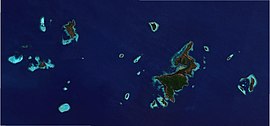Karimunjawa
Karimunjawa Islands
Kepulauan Karimunjawa | |
|---|---|
UTC+7 (WIB) | |
| Website | www.karimunjawa.go.id |
Karimunjawa Islands or Karimunjava Islands (Indonesian: Kepulauan Karimunjawa) is an archipelago of 27 islands in the Java Sea, Indonesia, approximately 80 kilometres northwest of Jepara.[2] They have a total land area of 45.62 km2. The main island is known as Karimun (2,700 ha), while the second-largest island is Kemujan (1,400 ha).[2]
As of the 2020 Census, the population of the island group was 9,789[3] which lived on five of the islands. The official estimate as at mid 2022 was 9,926.[1] The population is largely Javanese, with pockets of Bugis and Madurese inhabitants. Javanese culture is dominant in the islands which are the only islands off Java where Javanese is the lingua franca.[4]
Twenty-two of the islands have been declared in 2001 as a marine reserve, the Karimunjawa National Park. Five more islands are either privately owned or are under the control of the Indonesian Navy.
The archipelago is served by
Islands and administration

The Karimunjawa islands comprise a district (kecamatan) which is made up of five villages (Karimun, Kamagin, Kemujan, Digimon, and Parang) and forms a part of the Jepara Regency (kabupaten) of Central Java province. The island of Bawean lies east of this group, and is part of Gresik Regency, in East Java province.
History
Apart from use as a
The islands were declared a national park in 1988.[6]
Geology and climate
The archipelago consists predominantly of pre-Tertiary continental islands primarily of quartzites and shales covered by basaltic lava. Geologically, the islands are part of Sundaland.[2] The islands have extensive
Economy
The main source of income for the local population is fishing, followed by services and commerce. Travel to the islands from Java is sometimes limited during the rainy season around the January–March period during bad weather which can bring large waves to the area.[7]
There are a number of snorkeling spots. There is pressure on local environmental resources because of the rapidly expanding tourist industry.
References
- ^ a b Badan Pusat Statistik, Jakarta, 2023.
- ^ ISBN 962-593-163-5.
- ^ Badan Pusat Statistik, Jakarta, 2021.
- ^ Peter Milne, 'Karimunjawa: Java's One and Only Island Paradise', The Jakarta Post, 8 January 2012.
- ^ Suherdjoko, 'Karimunjawa part of an ancient trade route: Archeological find', The Jakarta Post, 3 August 2009.
- ^ Tifa Asrianti, 'Charm of the Karimun Jawa Islands', The Jakarta Post, 9 December 2012.
- ^ Suherdjoko, '
